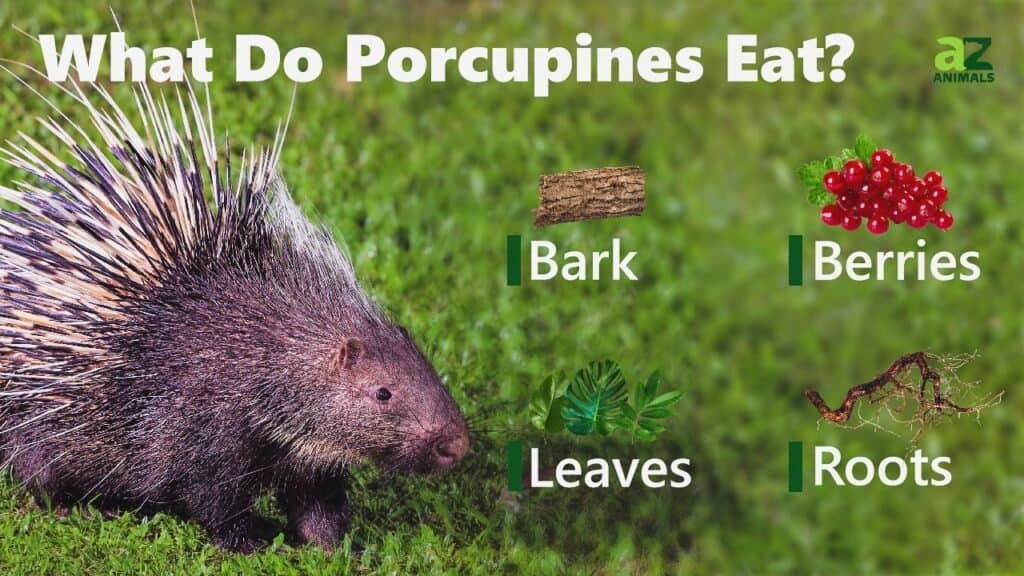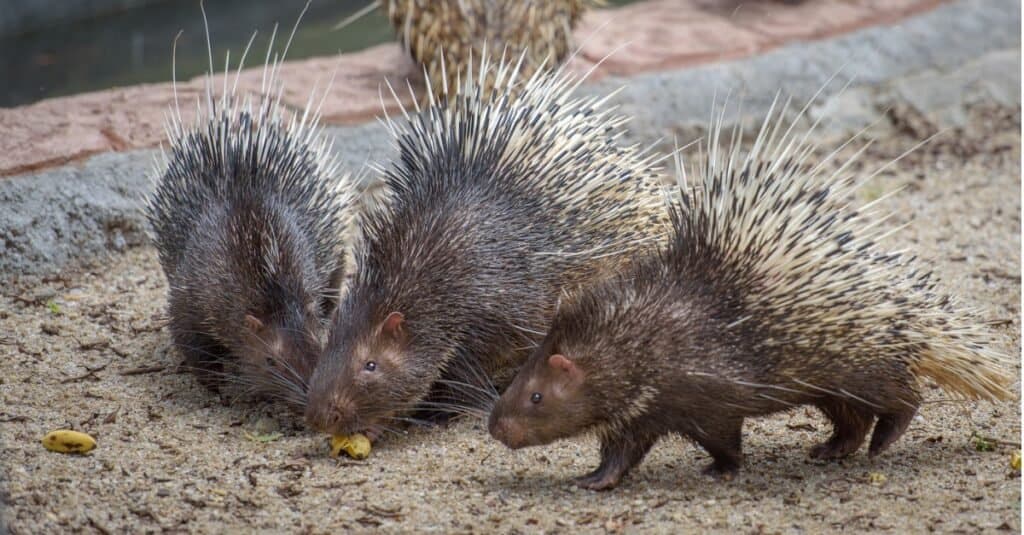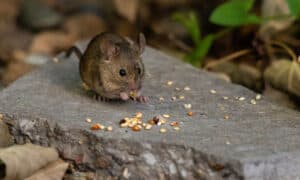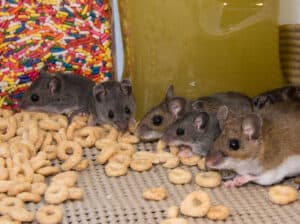- Depending on where they live, they might engage in an insectivorous or carnivorous lifestyle.
- The presence of their quills notwithstanding, porcupines are considered rather tasty by birds of prey, pumas, and wolves among other predators.
Instantly recognizable from the sharp, spiky quills covering their bodies, porcupines are among the largest rodents on earth. Most people know what they look like, but what do porcupines eat? The vast majority of porcupine species are strict herbivores, but there are exceptions. Depending on where they live, many porcupines’ diets shift with the changing seasons.

What Do Porcupines Eat?
Because most of these rodents are strict herbivores, they mostly eat things like fruits, leaves, roots, and bulbs. Their diets vary by region, species, and even season, but popular staples include tree barks, sweet potatoes, bamboo shoots, beans, nuts, skunk cabbage, twigs, and carrots. Some species may opportunistically feed on carrion, or dead animals, as well as insects.
How Do Porcupines Eat?
These animals overwhelmingly eat foods that they find scattered on the ground, and they also commonly pull bark, twigs, and leaves from the lower branches of trees. Some species may feed on dead animals that they come across; others may stalk and consume insects and small animals, but that tends to be the exception rather than the rule.
What Eats Porcupines?
Thanks to their sharp quills, porcupines aren’t targeted by other creatures very often. However, when they are, their most common predators include the following:
- wolves
- fisher cats
- great horned owls
- ocelots
- bobcats
- pumas
- mountain lions
- coyotes
- lynxes
Tucking into fresh porcupine can be a risky undertaking for predators.
Especially since they risk getting attacked by their quarry racing backwards towards them.
However a few wily felines have learnt to grab porcupines by the head or even work their way beneath those spines – both of which require considerable skill to pull off.
What Do Porcupines Eat In the Summer vs. In the Winter?
Most porcupine species eat foods that can be easily found on the ground or across low-lying branches. Therefore, their diets typically change from season to season. In the winter, for example, North American porcupines primarily eat the inner bark from trees and evergreen needles. On the other hand, porcupines’ diets may expand considerably in the summer, depending on their habitat. For instance, in the summer, North American porcupines are known to eat seeds, berries, grasses, roots, stems, and leaves.
A Complete List of Foods Porcupines Eat
As noted previously, porcupines’ diets vary by habitat, species, and season. When considering the entire extent of porcupine species living on earth today, however, the following is a complete list of foods they commonly eat:
- evergreen needles
- seeds
- nuts
- berries
- leaves
- grasses
- twigs
- roots
- stems
- tree bark
- various fruits found on the ground
- taros
- bamboo shoots
- sugarcane
- beans
- peanuts
- sweet potatoes
- buds
- carrots
- cocoa nuts
- insects
- carrion
- animal bones
Porcupines fall into two main categories: Old World porcupines of the family Hystricidae and New World porcupines of the family Erethizontidae.

©iStock.com/photomaru
What Do Old World Porcupines Eat?
Old World porcupines, sturdily built with rounded heads and flattened, cylindrical spines, are primarily found in Africa, Asia, and southern Europe. Foods that Old World porcupines commonly eat vary by species. Some examples include the following:
- African Bush-Tailed Porcupines – This species, which has the scientific name Atherurus africanus, is among the largest rodents on the planet. Primarily herbivores, these porcupines mostly eat tree bark, fruits, leaves, nodules and bulbs. Occasionally, they are also known to eat dead animal carcasses that they stumble upon in the wild.
- Asiatic Bush-Tailed Porcupines – Asiatic bush-tailed porcupines, Atherurus macrourus, are smaller in stature than their African counterparts. They also tend to be herbivores, primarily eating bamboo shoots, yarns, taros, fruits and vegetables. This species may also scavenge animal horns and bones. Asiatic bush-tailed porcupines also sometimes eat insects, which they dig out of hiding places.
- Sumatran Porcupines – This species of Old World porcupines has the scientific name Hystrix sumatrae. Found exclusively in the tropical forests of the Sumatran Islands of Indonesia, they are also primarily herbivorous. Therefore, they mostly eat fallen fruits, including mangoes and melons. They are also known to eat beans, peanuts and sugarcane, and they sometimes dig up root vegetables – primarily sweet potatoes.
What Do New World Porcupines Eat?
Large rodents with blunt noses and rounded heads, New World porcupines in the wild are found across North and South America. Long, soft hairs are interspersed between their spiky spines, helping them stand out from their Old World counterparts. Foods commonly eaten by various species of Old World porcupines are outlined below:
- North American Porcupine – As its common name implies, the North American porcupine – scientific name Erethizon dorsatum — is found across the North American continent, primarily in scrublands and forested areas. True herbivores, North American porcupines eat clover, evergreen needles, skunk cabbage, fruits, twigs, leaves, bark and buds.
- Mexican Dwarf Hairy Porcupine – Found in forested mountain regions, scrublands and rainforests across Mexico, this species – scientific name Sphiggurus mexicanus — is also considered strictly herbivorous. Mexican dwarf hairy porcupines primarily eat carrots, sweet potatoes, seeds, fruits, buds and leaves.
- Bristle-Spined Porcupine – This species, which has the scientific name Chaetomys subspinosus, is primarily found in forested areas along the Atlantic coast of Brazil. As strict herbivores, they mostly eat leaves, fruits, nuts, coconuts and various nuts.
Up Next…
Keep reading these posts for more incredible information about key animal facts.
- Porcupine vs Hedgehog: 8 Main Differences: Who’s the carnivore? Who has greater stinging power? Who prefers the offensive rather than the defensive? It’s all revealed right here.
- 10 Most Incredible Porcupine Facts: It’s larger than your average rodent and some of its skills might be considered superpowers. Discover how much more there is to this prickly mammal.
- Are Porcupines Rodents? A scientific name and an appearance which is somewhat deceiving, make this question one worth asking. Are they or aren’t they?
The photo featured at the top of this post is © iStock.com/Carol Gray
FAQs (Frequently Asked Questions)
What do porcupines eat in the summer?
During the summer, porcupines are known to eat things like fresh berries, grasses, leaves, roots, stems, and seeds. They may either find and eat these foods off the ground or pull them from low-hanging branches.
What is the natural predator of a porcupine?
Thanks to their spiky spines, or quills, porcupines in the wild have strong natural defenses. However, depending on their habitat, they may be targeted by various types of predators. Common porcupine predators include ocelots, pumas, mountain lions, bobcats, fishers, coyotes, wolves, wolverines, and lynxes. In some areas, birds of prey – primarily great horned owls – may also prey upon various porcupine species.
What kinds of fruit do porcupines eat?
In the summer, porcupines across many habitats are known to eat many types of berries, which they may pull from bushes and other plants or eat right off of the ground. Similarly, most fruits that they eat are taken from off the ground. These may include mangoes, avocadoes, bananas, grapes, and melons. However, in the winter, fruits aren’t available in colder climates, so they go without until spring and summer return.
Thank you for reading! Have some feedback for us? Contact the AZ Animals editorial team.






